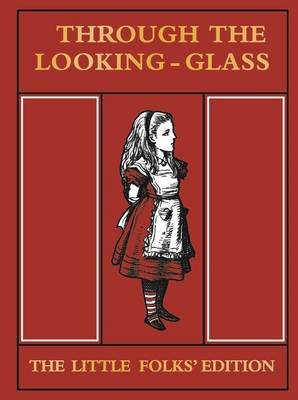Through the Looking Glass Little Folks Edition Synopsis
Based on the original edition of Through the Looking-Glass Little Folks' Edition, a highlight of the Macmillan archive, this charming small format hardback is a companion to The Little Folks' Edition of Alice's Adventures in Wonderland.
With red cloth binding, foil on the front cover and spine, and gold-sprayed edges to the pages, this is a really delightful gift, and specially abridged for younger readers to around one sixth the length of the original, it's a perfect introduction to the second of Carroll's classic Alice titles.
This beautiful book is reproduced in full colour with over thirty original illustrations by Sir John Tenniel.
About This Edition
| ISBN: |
9781509820498 |
| Publication date: |
14th July 2016 |
| Author: |
Lewis Carroll |
| Illustrator: |
Sir John Tenniel |
| Publisher: |
Macmillan Children's Books an imprint of Pan Macmillan |
| Format: |
Hardback |
| Suitable For: |
|
| Other Genres: |
|
About Lewis Carroll
Lewis Carroll was born Charles Lutwidge Dodgson on January 27, 1832, the eldest son and third of eleven children born to Frances Jane Lutwidge and the Reverend Charles Dodgson. Carroll had a happy childhood. His mother was patient and gentle, and his father, despite his religious duties, tutored all his children and raised them to be good people. Carroll frequently made up games and wrote stories and poems, some of which were similar to his later published works, for his seven sisters and three brothers.
He was educated at Richmond School in Yorkshire, Rugby School and Christ Church, Oxford. Although his years at Rugby School (1846–49) were unhappy, he was recognized as a good student, and in 1850 he was admitted to further study at Christ Church, Oxford.
He graduated in 1854, and in 1855 he became mathematical lecturer at the college, where he was a somewhat eccentric and withdrawn character. This permanent appointment, which not only recognized his academic skills but also paid him a decent sum, required Carroll to take holy orders in the Anglican Church and to remain unmarried. He agreed to these requirements and was made a deacon in 1861.
Carroll loved to entertain children, and it was Alice, the young daughter of Henry George Liddell, Dean of Christ Church, who can be credited with his pinnacle inspiration. Alice Liddell remembers spending many hours with Carroll, sitting on his couch while he told fantastic tales of dream worlds. During an afternoon picnic with Alice and her two sisters, Carroll told the first iteration of what would later become Alice's Adventures in Wonderland. When Alice arrived home, she exclaimed that he must write the story down for her.
He fulfilled the small girl's request, and through a series of coincidences, the story fell into the hands of the novelist Henry Kingsley, who urged Carroll to publish it. The book Alice's Adventures in Wonderland was released in 1865. It gained steady popularity, and as a result, Carroll wrote the sequel, Through the Looking-Glass and What Alice Found There, which contained the nonsense poem classic The Jabberwocky (1871). By the time of his death, Alice had become the most popular children's book in England, and by 1932 it was one of the most popular in the world.
Unlike most of the children's books of the day, Alice and through the Looking Glass did not attempt to convey obvious moral lessons. Nor did they contain what critics have tried to insist are there—hidden meanings relating to religion or politics. They are delightful adventure stories in which a normal, healthy, clearheaded little girl reacts to the "reality" of the adult world. Their appeal to adults as well as to children lies in Alice's intelligent response to ridiculous language and action.
Carroll published several other nonsense works, including The Hunting of the Snark (1876), Sylvie and Bruno (1889), and Sylvie and Bruno Concluded (1893). He also wrote a number of pamphlets poking fun at university affairs, which appeared under a fake name or without any name at all, and he composed several works on mathematics under his true name. In 1881 Carroll gave up his lecturing to devote all of his time to writing.
Lewis Carroll died of bronchitis in his sister's home in Guildford on 14 July, 1898.
More About Lewis Carroll
